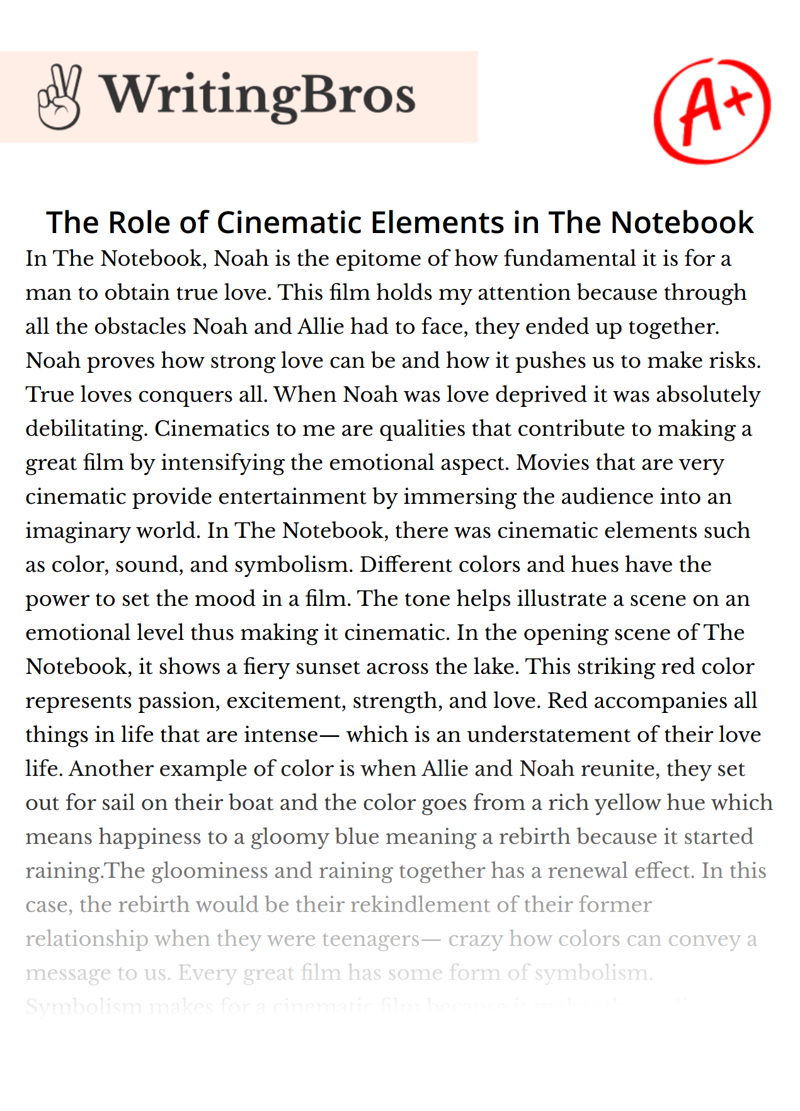The Role of Cinematic Elements in The Notebook

In The Notebook, Noah is the epitome of how fundamental it is for a man to obtain true love. This film holds my attention because through all the obstacles Noah and Allie had to face, they ended up together. Noah proves how strong love can be and how it pushes us to make risks. True loves conquers all. When Noah was love deprived it was absolutely debilitating. Cinematics to me are qualities that contribute to making a great film by intensifying the emotional aspect. Movies that are very cinematic provide entertainment by immersing the audience into an imaginary world. In The Notebook, there was cinematic elements such as color, sound, and symbolism.
Different colors and hues have the power to set the mood in a film. The tone helps illustrate a scene on an emotional level thus making it cinematic. In the opening scene of The Notebook, it shows a fiery sunset across the lake. This striking red color represents passion, excitement, strength, and love. Red accompanies all things in life that are intense— which is an understatement of their love life. Another example of color is when Allie and Noah reunite, they set out for sail on their boat and the color goes from a rich yellow hue which means happiness to a gloomy blue meaning a rebirth because it started raining.The gloominess and raining together has a renewal effect. In this case, the rebirth would be their rekindlement of their former relationship when they were teenagers— crazy how colors can convey a message to us.
Every great film has some form of symbolism. Symbolism makes for a cinematic film because it makes the audience think. Let's take The Notebook for example, the old oak tree symbolizes their earliest feelings of love as well as how love is always evolving and doesn’t stop growing until it dies. Another symbolic element was in the very beginning, there are a flock of birds flying by overhead. Birds represent freedom and it is also referenced later in the movie in the most infamous quote “if you’re a bird. I’m a bird.” Also when Allie and Noah reunite during a boat ride, white birds surround them. Towards the end of the film, once again a flock of birds fly by overhead. These birds symbolize togetherness. Last but not least, the most symbolic element of the film is the notebook. Towards the end of Allie and Noah's life, Allie’s alzheimers was getting worse and worse making it impossible to remember anything, however their love was so strong, powerful, and memorable that she would end up remembering their younger days together. This shows that when the love is true absolutely nothing can get in the way.
Sound has a powerful ability to set the emotion of a scene. Back to the row boat scene, as they started rowing peaceful background music was playing which adds a sense of calmness that was only achieved when they were together. When it started raining during this scene, if you pay attention closely, the rain got louder the more their romance was rekindling. The last example would be right before they kissed there was loud thunder which represented the turning point of their relationship.
Movies are multidimensional, all these aspects create layers of intensity in which they build emotion upon. You cannot have a sad scene without melancholy music or sound to match. You must have symbols to represent things that have more important meanings. We need colors to represent the potency of emotions. All these aspects make for a cinematic film and are pivotal especially in Romance films.
References
- Evans, J. (2017). The semiotics of color: A rhetorical analysis of color symbolism in the film Notebook. Cinema Journal, 56(4), 85-103.
- Katz, D. (2018). Colors and meaning: The significance of color in literature and film. McFarland & Company, Inc.
- Pendergast, T. (2014). The symbolism of color in movies and literature. Salem Press Encyclopedia.
- Santoro, G. (2017). Color symbolism and the interpretation of The Notebook. Bloom's Literature.
- Wagner, L. (2018). Color as a cinematic language: An analysis of The Notebook. Journal of Film and Video, 70(1-2), 59-72.
Cite this Essay
To export a reference to this article please select a referencing style below

